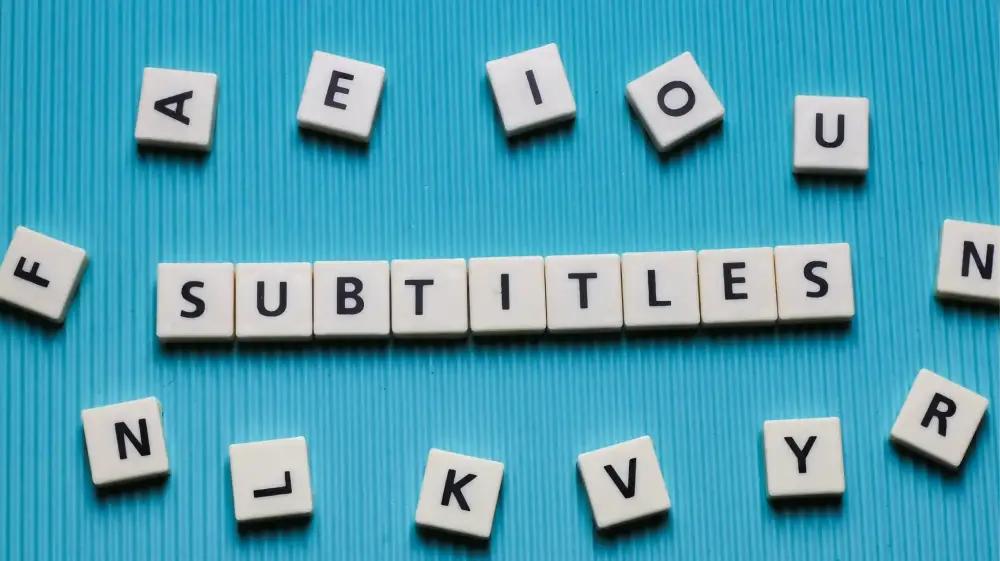Summary
Subtitling is the process of conveying an audiovisual work into written content, from one language into another. It is the translation of audible content and it has many benefits. Subtitling is different from captions, and there are specific rules for subtitling. Also, there are some basic principles one must know to be able to successfully complete the subtitling task.
Get our subtitling and captions translation now
What are subtitles?
Subtitles are the translated form of audiovisual content that is displayed on the screen and can be read at the same time as speaking. It is used for all recorded audiovisual works including audio, videos, podcasts, interviews, movies, series, documentaries, and more. Subtitles are used in nearly all fields since they are known to be very beneficial, such as the legal field, the medical field, the technical field, economics, gaming and entertainment, and more. Subtitles aim at making the audible content understandable in case viewers or listeners don’t understand the language of the audiovisual work.
Some use the terms subtitles and captions interchangeably, and even if they have a very similar meaning, they still have one difference. Captions are for the deaf and hard of hearing, and they are usually the written form of the audiovisual work but in the same language as the speakers. However, subtitles can be considered captions if they were for the deaf and hard of hearing who are unable to hear the audible content and unable to understand the source language.
Get our translation and writing services now
Benefits of subtitles
Subtitles have many benefits and more individuals are using them nowadays. Subtitles, which are the written form of an audiovisual work that is translated from one language into another, is useful for the following reasons:
More audience
Subtitles are known for their ability to reach more audiences. Audiovisual work, no matter what it is, can reach all corners of the world if it were translated.
Highlighting important details
Subtitles make it possible for the important details to be highlighted. Subtitles include phone numbers, amounts, websites, links, and even addresses that might be important.
Beneficial for language learners
Thanks to subtitles, language learners are able to understand the new language and become even more fluent in it since they are able to read the meaning of what is being said at the same time.
Beneficial for the deaf and hard of hearing
The deaf and hard of hearing might need subtitles to be able to watch a video or to listen to a podcast that isn’t in the language that they understand.
Boosting focus
Subtitles are the go-to option for the ones who are unable to stay focused for a long period of time, even if they understand the source language. Therefore, they will need subtitles to stay focused.
Learning how to write properly
Not all native speakers know how to write properly. That is why, by using subtitles, individuals are able to read the content in their mother language and learn how to write properly.
Beyond Subtitles: Exploring the Various Types of Audiovisual Translation
Subtitling basic principles
There are basic principles one must stick to while subtitling. These principles are:
- Natural translation. Subtitles must be natural and the translated version must adapt to all the target language rules. This is the only way that guarantees natural translation, which is considered to be the most appropriate translation.
- The phrase must never be separated. While cutting the subtitle and separating the two lines, the phrase must not be interrupted. This means that nouns and adjectives and verbs and adverbs shouldn’t be separated.
- Usage of short hyphens (-) in the case of more than one speaker. Short hyphens must always be used in dialogues or conversations for the viewers to be able to identify the change of speakers.
- Usage of italics. Italics must be used for songs or audio that are not close to the scene of electronic devices. This is a way that is used to be able to identify how far the voice or the sound is.
- Usage of quotation marks (“…”), abbreviations that are recognized, and figures when possible.
- Avoidance of capital letters when possible, as they must only be used for titles, written content in images, and signs as well.
- The final result must be synchronized with the audiovisual file, which means that the written content must appear at the same time as speaking, neither before nor after.
The Difference Between Subtitles and Dubbing
Subtitling tips
To be able to successfully complete the process of subtitling, there are tips that subtitlers need to take into consideration. These tips are:
- Break into two lines the subtitle that consists of more than 42 characters.
- The maximum number of lines per subtitle is two lines. One can use less than two lines, but never moreز
- Try to keep the broken lines close in length as much as possible.
- When one wants to break the lines, “linguistic wholes” must be kept together.
- The subtitle reading speed must never exceed 21 characters per second. This is the maximum.
- Try compressing subtitles that are over 21 characters per second.
- Try preserving meaning as much as possible.
- Avoid explaining the meaning of a term. Instead, use an appropriate translation that correctly conveys the meaning.
- Subtitles must always be one hundred percent accurate.
- When two synonyms are used, translate both of them into one word that conveys the meaning of both words of the source language.
- Know your target audience. The country of the source language and the country of the target language might differ in terms of culture. You must always know who your target audience is.
- Avoid literal translation as much as possible. Literal translation negatively affects the quality of the subtitles.
- Translate the meaning and not the structure of the sentence. The structure must be one of the target languages.
- Avoid translating a word before being pronounced.
- Never translate what you don’t understand. Don’t translate words that aren’t clear or sentences that you don’t get their true meaning.
- Conduct research if needed. Research is an integral part of the translation process, and subtitling is no exception.
- Never omit important information or details. You can only omit what doesn’t affect the meaning of the spoken content.
- You can add some words if it helps in understanding the meaning even more.
Mastering Technical Translation: Types & Qualifications of Top Translators
Subtitling rules
There are certain rules subtitlers must follow to be able to deliver the high-quality outcome they want.
Technical rules:
- Arial is the standard font used for subtitles, and the point size must be 47 to be able to fit with the content of the high resolution, and the point size must be 32 to be able to fit with videos that are of standard definition.
- Line length must never exceed 47 characters per line.
- The minimum time of subtitle display must not be under 1 second. If it is possible, it is better to have the subtitles displayed for a minimum of 2 seconds.
- The maximum time of subtitle display must not exceed 7 seconds.
Breaking Barriers: Inspiring Interlingual Translation Examples
Transcription rules:
- Subtitles must always be displayed within a text-safe area.
- Each subtitle should include a maximum of 2 lines.
- Line splits should be based on linguistic criteria and grammar must be always taken into consideration.
- One-word lines must be avoided if possible.
- Subtitle lines must match the dialogue as much as possible.
- Subtitlers must aim at avoiding overlapping of subtitles that are across shot changes.
- Each line must include a maximum of 47 characters.
- To be able to ensure the correct display of all foreign characters, subtitlers must use UTF-8 encoding.
Timing
- Subtitles must always start when the dialogue starts. They should never start before the dialogue or after it.
- It is better to remove the subtitles after the dialogue is finished.
- Subtitles must follow the rhythm of the dialogue for the speech to be readable.
- Subtitles must always be within shot changes parameters and there must be 2 frames on each side.
- The reading speed must never exceed 250 words per minute for content that is intended for adults.
- The reading speed must never exceed 180 words per minute for content that is intended for younger individuals.
Characters and brackets
- Language must be indicated within square brackets in case foreign dialogue occurs.
- If subtitlers want to identify speakers, the name must be capitalized before the speech.
- In case the dialogue refers to speech, subtitlers must use double quotation marks.
- To indicate music, subtitlers must include musical notes at both the beginning and the end of the line, and the lyrics must be written in italics.
Usage of italics
- When the dialogue is from a device such as a computer, a telephone, a radio, or a television, it must be written in italics.
- For speakers and narrators that aren’t on screen, the dialogue must be written in italics.
- If there is a certain word that subtitlers want to emphasize, it must be written in italics.
- Song lyrics must be written in italics.
Foreign speech
- In case the subtitle won’t be translated, there must be an indication of foreign speech (example: [Spanish]).
- If there were foreign words that are commonly known and used, subtitlers must write them in italics in the source spelling and use their punctuation. (example: Merci!)
Accuracy of subtitles
- If subtitlers have to shorten sentences, truncations must be a priority.
- The speech must never be simplified.
Numbers
- Numbers from 1 to 10 should be written in letters (for example two, ten), whereas all other numbers must be portrayed as digits.
Subtitle punctuation rules
- Punctuation in subtitles must be adapted to the target language. Subtitle breaks must always be at logical points. Ideally, line break is best if it is at a piece of punctuation such as a full stop, a dash, or even a comma.
Subtitle capitalization rules
- In subtitles, the first word of the sentence must always be capitalized.
- The first letter of proper nouns must be capitalized in subtitles.
- The first letters of country names, city names, and other names and nouns that are usually capitalized must be capitalized in subtitles as well.
- The name of speakers must be capitalized before the speech if subtitlers choose to write them.
- In titles, the first letter of each word must be capitalized
How long does subtitling take?
The time it takes for the subtitling process to be successfully completed depends on many factors. It is important to mention that if the audiovisual content isn’t transcribed, then it might take more time to be translated. The reason is that some words might not be easily understood which will take more time to be able to identify them. However, on average, 1 minute of audiovisual content can take up to 5 minutes to be translated, and even more.
Nevertheless, the subtitling process differs from person to person. If the subtitler is fast, it might not take as much time as the subtitler that is slow. Not to mention that the field of audiovisual work is also an important part to be considered; the more the audiovisual content is specific, the more research it will require, and the more time it will take to be translated. Also, if the subtitler is qualified enough and is specialized in the field of audiovisual work, it might take less time.
Beyond Spelling Errors: Understanding Editing vs. Copy Editing
Can someone major in subtitling?
Usually, translators are the ones who handle subtitling projects. For that reason, one must start by earning a Bachelor's Degree in Arts in Translation to be able to successfully complete subtitling tasks. Individuals can’t major in subtitling, but they can receive training that can help them.
Get a quote now and let our translators bridge the gap between languages!






